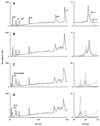HIV-1 inactivation by 4-vinylpyridine is enhanced by dissociating Zn(2+) from nucleocapsid protein
- PMID: 18304600
- PMCID: PMC2553892
- DOI: 10.1016/j.virol.2008.01.045
HIV-1 inactivation by 4-vinylpyridine is enhanced by dissociating Zn(2+) from nucleocapsid protein
Abstract
Selective inactivation of critical cysteine residues in human immunodeficiency virus type one (HIV-1) was observed after treatment with 4-vinylpyridine (4-VP), with and without the membrane-permeable metal chelator N,N,N',N'-tetrakis(2-pyridylmethyl)-ethylenediamine (TPEN). Chromatographic analysis showed that cysteines contained within nucleocapsid zinc fingers, in the context of whole virus or purified protein, were essentially unreactive, but became reactive when a chelator was included. Virus treated with 4-VP showed only a modest decrease in infectivity; after TPEN addition, nearly complete inactivation of HIV-1 occurred. Similarly, quantitation of viral DNA products from 4-VP-treated virus infections showed no significant effects on reverse transcription, but did show a 14-fold reduction in proviruses; when TPEN was added, a 10(5)-fold decrease in late reverse transcription products was observed and no proviruses were detected. Since 4-VP effectiveness was greatly enhanced by TPEN, this strongly suggests that modification of nucleocapsid zinc fingers is necessary and sufficient for HIV-1 inactivation by sulfhydryl reagents.
Figures



Similar articles
-
Inhibition of Vpx-Mediated SAMHD1 and Vpr-Mediated Host Helicase Transcription Factor Degradation by Selective Disruption of Viral CRL4 (DCAF1) E3 Ubiquitin Ligase Assembly.J Virol. 2017 Apr 13;91(9):e00225-17. doi: 10.1128/JVI.00225-17. Print 2017 May 1. J Virol. 2017. PMID: 28202763 Free PMC article.
-
Chemical inactivation of retroviral infectivity by targeting nucleocapsid protein zinc fingers: a candidate SIV vaccine.AIDS Res Hum Retroviruses. 1998 Oct;14 Suppl 3:S311-9. AIDS Res Hum Retroviruses. 1998. PMID: 9814959
-
Inhibition of HIV-1 replication by a bis-thiadiazolbenzene-1,2-diamine that chelates zinc ions from retroviral nucleocapsid zinc fingers.Antimicrob Agents Chemother. 2010 Apr;54(4):1461-8. doi: 10.1128/AAC.01671-09. Epub 2010 Feb 1. Antimicrob Agents Chemother. 2010. PMID: 20124006 Free PMC article.
-
Sites, mechanism of action and lack of reversibility of primate lentivirus inactivation by preferential covalent modification of virion internal proteins.Curr Mol Med. 2003 May;3(3):265-72. doi: 10.2174/1566524033479889. Curr Mol Med. 2003. PMID: 12699362 Review.
-
Targeting the viral nucleocapsid protein in anti-HIV-1 therapy.Mini Rev Med Chem. 2008 Jan;8(1):24-35. doi: 10.2174/138955708783331603. Mini Rev Med Chem. 2008. PMID: 18220982 Review.
Cited by
-
Antibody-mediated depletion of viral reservoirs is limited in SIV-infected macaques treated early with antiretroviral therapy.J Clin Invest. 2021 Mar 15;131(6):e142421. doi: 10.1172/JCI142421. J Clin Invest. 2021. PMID: 33465055 Free PMC article.
-
Blocking premature reverse transcription fails to rescue the HIV-1 nucleocapsid-mutant replication defect.Retrovirology. 2011 Jun 17;8:46. doi: 10.1186/1742-4690-8-46. Retrovirology. 2011. PMID: 21682883 Free PMC article.
-
Rational design and in vivo selection of SHIVs encoding transmitted/founder subtype C HIV-1 envelopes.PLoS Pathog. 2019 Apr 3;15(4):e1007632. doi: 10.1371/journal.ppat.1007632. eCollection 2019 Apr. PLoS Pathog. 2019. PMID: 30943274 Free PMC article.
-
A succession of mechanisms stimulate efficient reconstituted HIV-1 minus strand strong stop DNA transfer.Biochemistry. 2009 Mar 3;48(8):1810-9. doi: 10.1021/bi802149j. Biochemistry. 2009. PMID: 19192967 Free PMC article.
-
Factors that determine the efficiency of HIV-1 strand transfer initiated at a specific site.J Mol Biol. 2009 Dec 11;394(4):694-707. doi: 10.1016/j.jmb.2009.10.036. Epub 2009 Oct 21. J Mol Biol. 2009. PMID: 19853618 Free PMC article.
References
-
- Anderegg G, Hubmann E, Podder NG, Wenk F. Pyridinderivate als komplexbildner. XI. Die thermodynamik der metallkomplexbildung mit bis-, tris- und tetrakis[(2-pyridyl)methyl]-aminen. Helv. Chim. Acta. 1977;60:123–140.
-
- Arslan P, Di Virgilio F, Beltrame M, Tsien RY, Pozzan T. Cytosolic Ca2+ homeostasis in Ehrlich and Yoshida carcinomas. A new, membrane-permeant chelator of heavy metals reveals that these ascites tumor cell lines have normal cytosolic free Ca2+ J. Biol. Chem. 1985;260:2719–2727. - PubMed
-
- Berg JM. Potential metal-binding domains in nucleic acid binding proteins. Science. 1986;232:485–487. - PubMed
Publication types
MeSH terms
Substances
Grants and funding
LinkOut - more resources
Full Text Sources
Medical

